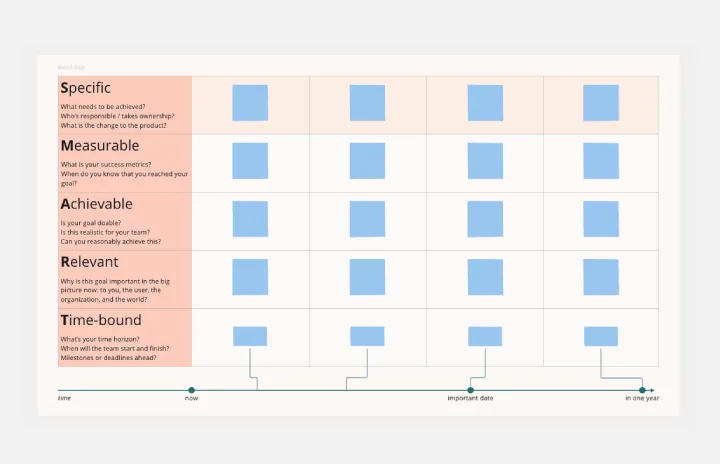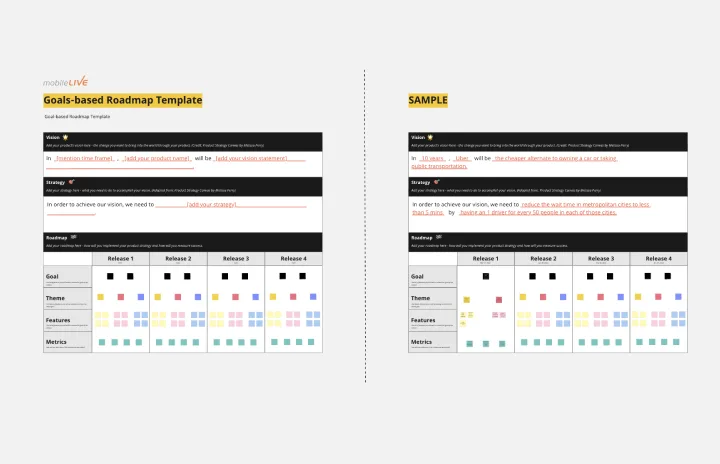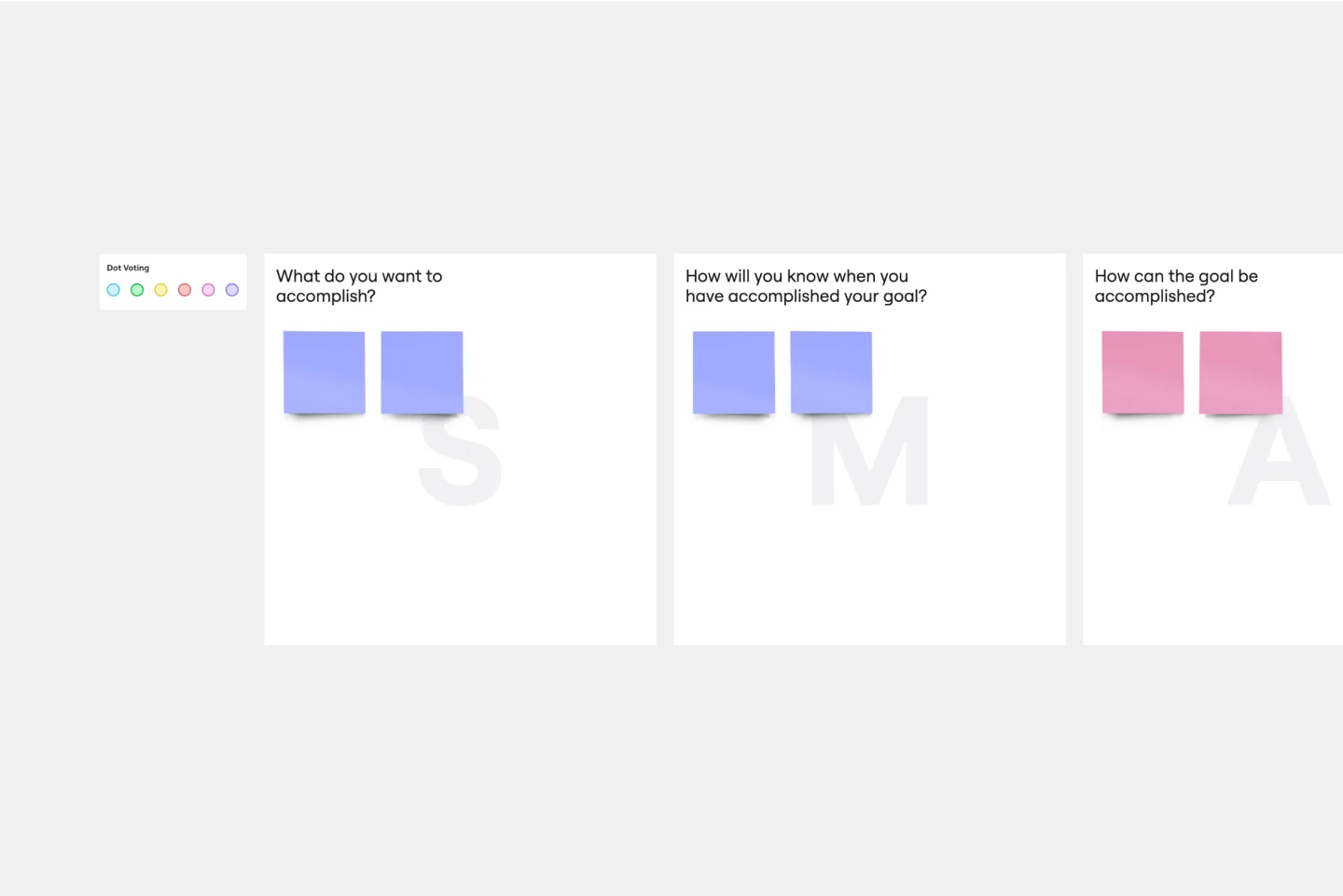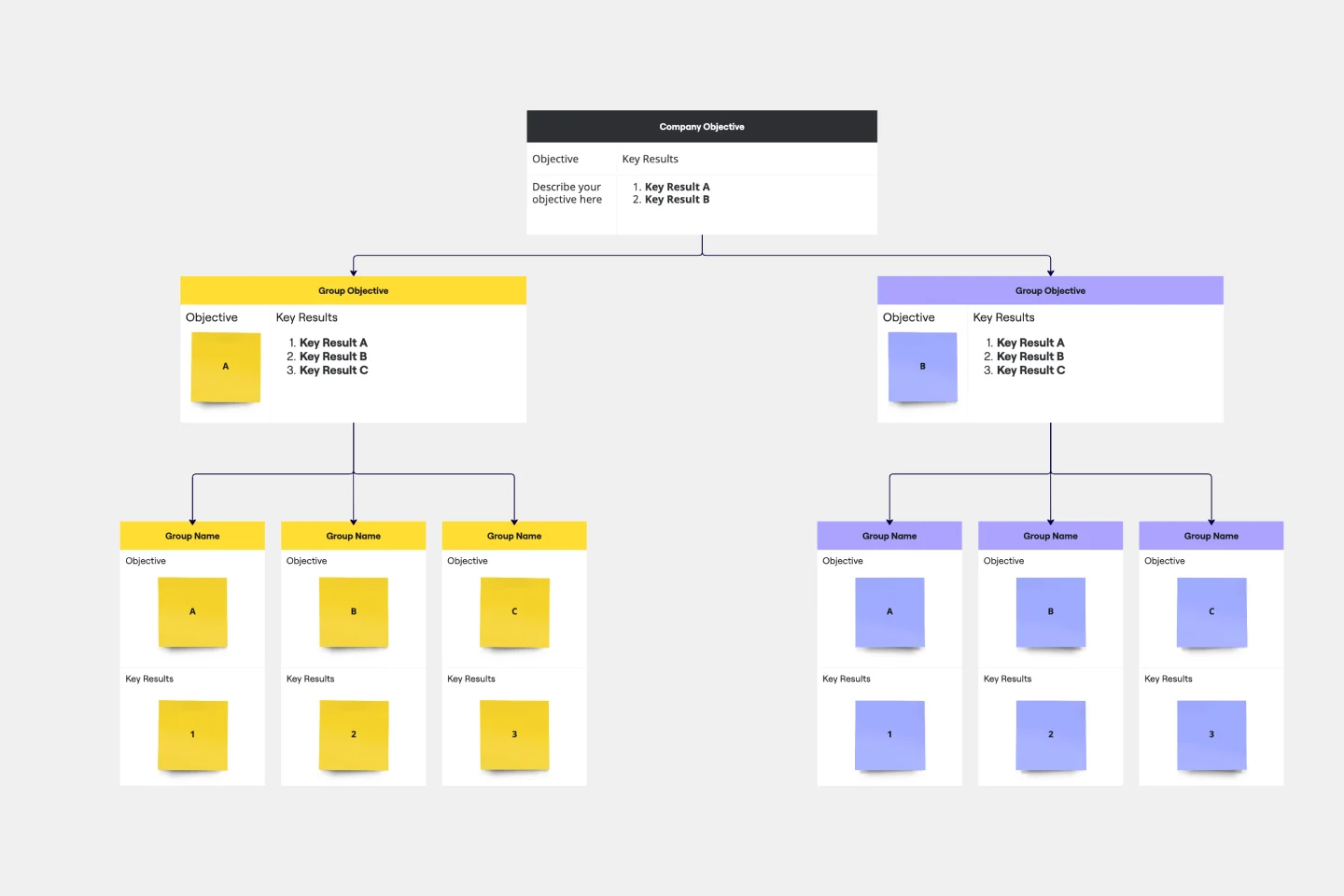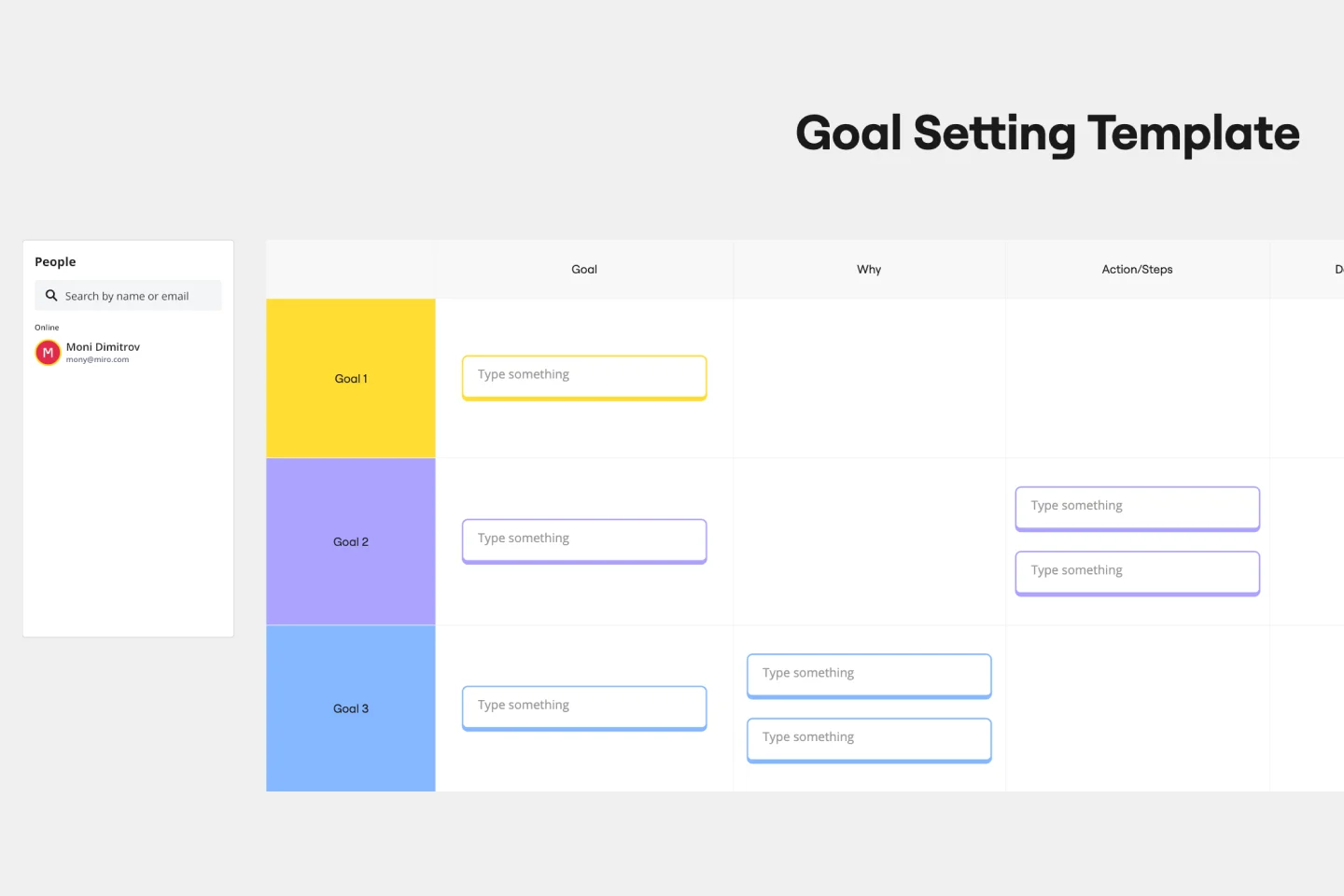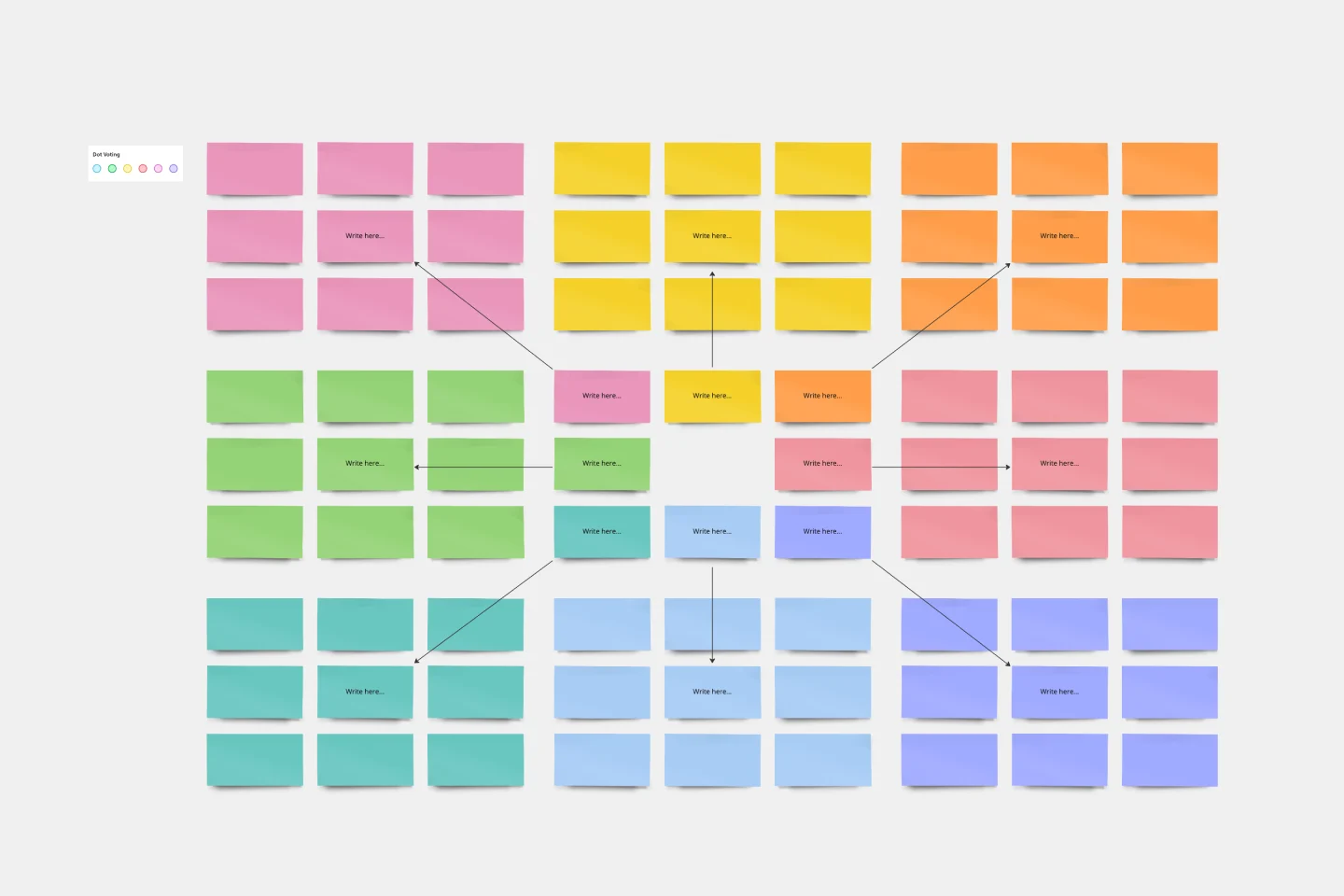SMART goal templates
Set clear and achievable objectives with Miro's SMART Goal templates collection. These customizable templates guide you in defining Specific, Measurable, Achievable, Relevant, and Time-bound goals.
SMART Agile Product Roadmap
Works best for:
Product Roadmap
Plan and manage your product development with the Smart Agile Product Roadmap. This template supports agile methodologies, helping you outline product features, set timelines, and prioritize tasks. Visualize the development process, track progress, and adjust plans as needed. Ideal for product managers, development teams, and agile practitioners, it ensures your product roadmap is clear, flexible, and aligned with business goals, enhancing collaboration and productivity.
Goals-based Roadmap
Works best for:
Roadmap, Planning, Mapping
The Goals-based Roadmap template enables teams to set clear objectives and chart a course for achieving them. By defining specific goals and milestones, teams can track progress and adapt their strategies accordingly. This template fosters accountability and transparency, ensuring that everyone is working towards common objectives. With a focus on outcomes, teams can prioritize initiatives that drive the greatest impact and value.
SMART Goals Template
Works best for:
Prioritization, Strategic Planning, Project Management
Setting goals can be encouraging, but can also be overwhelming. It can be hard to conceptualize every step you need to take to achieve a goal, which makes it easy to set goals that are too broad or too much of a stretch. SMART is a framework that allows you to establish goals in a way that sets you up for success. SMART stands for Specific, Measurable, Attainable, Relevant, and Timely. If you keep these attributes in mind whenever you set goals, then you’ll ensure your objectives are clear and reachable. Your team can use the SMART model anytime you want to set goals. You can also use SMART whenever you want to reevaluate and refine those goals.
Objectives and Key Results (OKRs) Template
Works best for:
Leadership, Strategic Planning, Project Planning
Clarity, focus, and structure — those are the key ingredients to feeling confident in your company’s directions and decisions, and an OKR framework is designed to give them to you. Working on two main levels — strategic and operational — OKRs (short for objectives and key results) help an organization’s leaders determine the strategic objectives and define quarterly key results, which are then connected to initiatives. That’s how OKRs empower teams to focus on solving the most pressing organizational problems they face.
Goal Setting Template
Works best for:
Strategic Planning
The Goal Setting Template simplifies the process and fosters strategic thinking. It includes key fields such as goal articulation, rationale, action steps, and blockers. This promotes accountability with a "Date Started" field and a clear deadline. The template turns aspirations into actionable plans with a heightened sense of accountability.
Mandala Chart Template
Works best for:
Planning, Brainstorming, Goal setting
The Mandala Chart Template helps you visualize the relationships between a central theme and its sub-themes. One of the key benefits is how it fosters a holistic understanding of any topic. This perspective ensures every detail is noticed, making it an invaluable asset for those aiming for comprehensive insight and thorough planning or a better understanding of their goals.
Join thousands of teams collaborating and doing their best work on Miro.
Sign up freeAbout the SMART Goals Template
The SMART Goals template helps you think strategically about your targets and develop a clear plan to accomplish them without sounding too vague or unrealistic. The SMART method points you in the right direction, and that’s why many professionals and teams use this methodology to create their strategies. It’s a great tool to design a plan and keep track of your progress.
What are SMART goals?
SMART is a framework that stands for: Specific, Measurable, Attainable, Relevant, and Timely. Keep each of these parameters in mind anytime you set a goal to adhere to the SMART framework. Setting SMART goals ensures that your objectives are both achievable and clear to all team members.
The SMART model can also be used to reevaluate and refine goals during the run of a project.
Why you'll love our SMART goals templates
A SMART goal template is highly beneficial for teams because it gives you a structured framework that improves clarity and focus. By ensuring that goals are Specific, Measurable, Achievable, Relevant, and Time-bound, people can clearly understand what is expected of them and the criteria for success. The SMART framework helps align individual contributions with the team or organization's overall objectives, fostering collaboration and accountability. Additionally, having a shared tool to define and track progress toward goals can boost motivation and promote open communication, as teams can easily identify milestones and adjust their strategies as needed. Overall, a SMART goal template empowers teams to work more effectively and achieve their objectives with confidence.
Benefits of setting SMART goals
Setting goals can be overwhelming, especially for a big project. It’s hard to conceptualize every step from the beginning, leading to objectives that are too broad or too much of a stretch.
SMART goals, by contrast, allow you to set goals that are clear, actionable, and effective. When working with a team, SMART goals help you stay aligned, agree on objectives, and keep up with deadlines. As an added benefit, you can loop in new employees without conducting extensive, time-consuming training and inform stakeholders easily by sharing the SMART Goals template.
Set your own SMART goals
Miro is the perfect tool to create and share your team’s SMART goals. Get started by selecting this SMART Goals template. Then, follow these steps to fill in each section:
S - Specific
What do you want to accomplish?
To be specific, add as many ideas as you can to identify patterns and determine the particular goal you want to pursue. Be careful not to get too broad and instead think about a specific area of focus.
As you brainstorm, add sticky notes, move them around the board, and cluster ideas with shapes and frames to stay organized.
M - Measurable
How will you know when you accomplished your goal?
Make sure your goals are measurable by adding details, metrics, and performance indicators, making note of anything you want to track. You can also add more templates to your board like Gantt charts, milestone charts, or action plans to have a more complete overview of a project.
A - Attainable
How can the goal be accomplished?
To make your goals attainable, consider splitting them into smaller steps that you prioritize so you can achieve results quickly. And, think about whether the goals are realistic, given constraints like financing.
R - Relevant
Will the goal meet your short- and long-term needs?
To ensure your goals are relevant, be sure to align them with your company’s goals, mission, and vision. You can easily share your goals with leaders to get their input.
T - Timely
When will the goal be accomplished?
To create timely goals, make sure each one gets assigned a deadline, whether short-term (“what can I do today?”) or long-term (“what can I do in six months?”). Time-bounded goals ensure lofty ideas can be broken down into actionable steps and make tracking milestones easier and more efficient.
Example of a practical SMART goal framework
Here is how to use SMART goals examples, and how you can put the SMART Goal framework into practice within the marketing context:
GOAL: your marketing team will increase brand awareness by 5% this quarter by revamping the content strategy and creating new content that improves your lagging brand awareness.
Specific: to increase brand awareness by 5%.
Measurable: if they achieve less than 5%, fail to revamp content strategy, or do not create new content, they have not reached their goal.
Attainable: the team has outlined the necessary steps for achieving this goal.
Relevant: the team acknowledges that their current brand awareness is lagging.
Time-based: the team has determined that they will achieve their goal by the end of the quarter.

